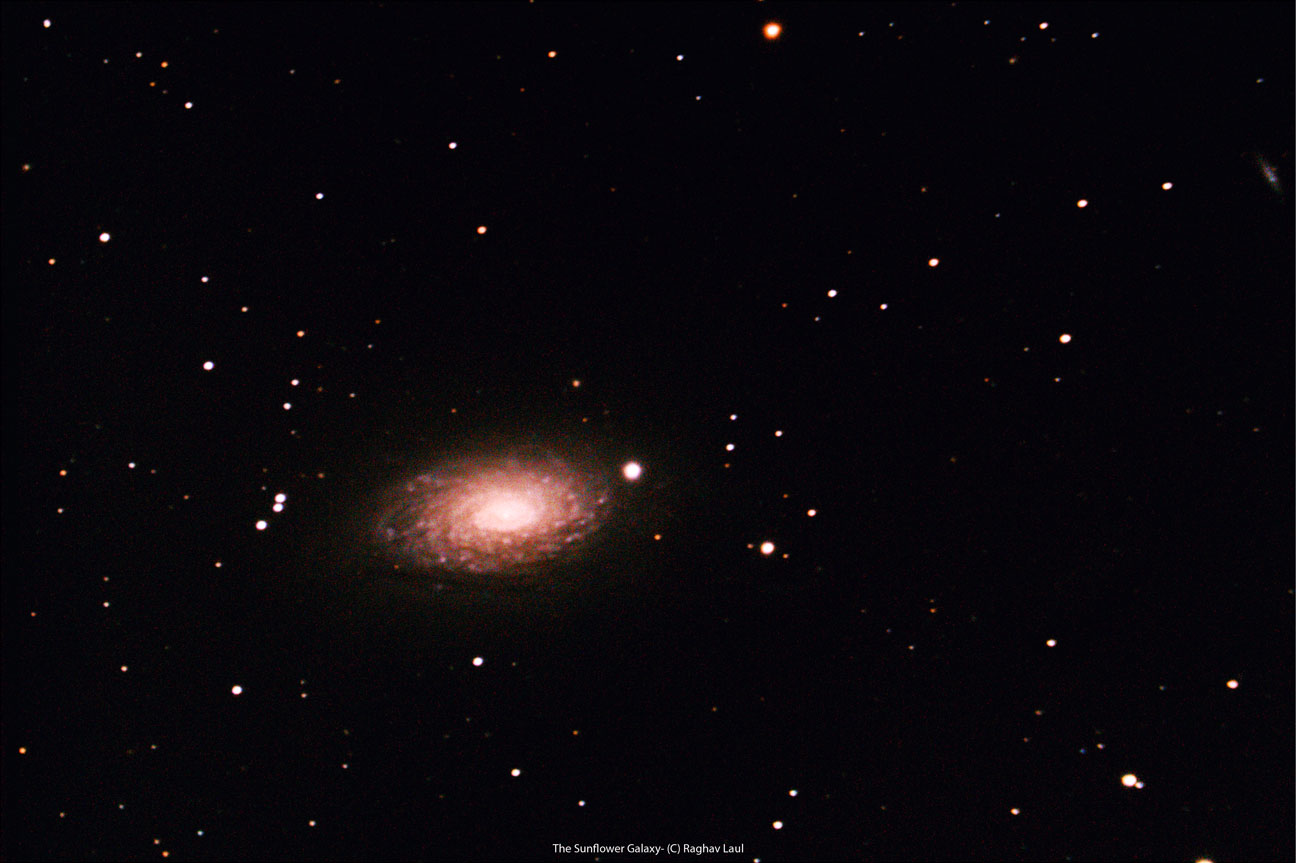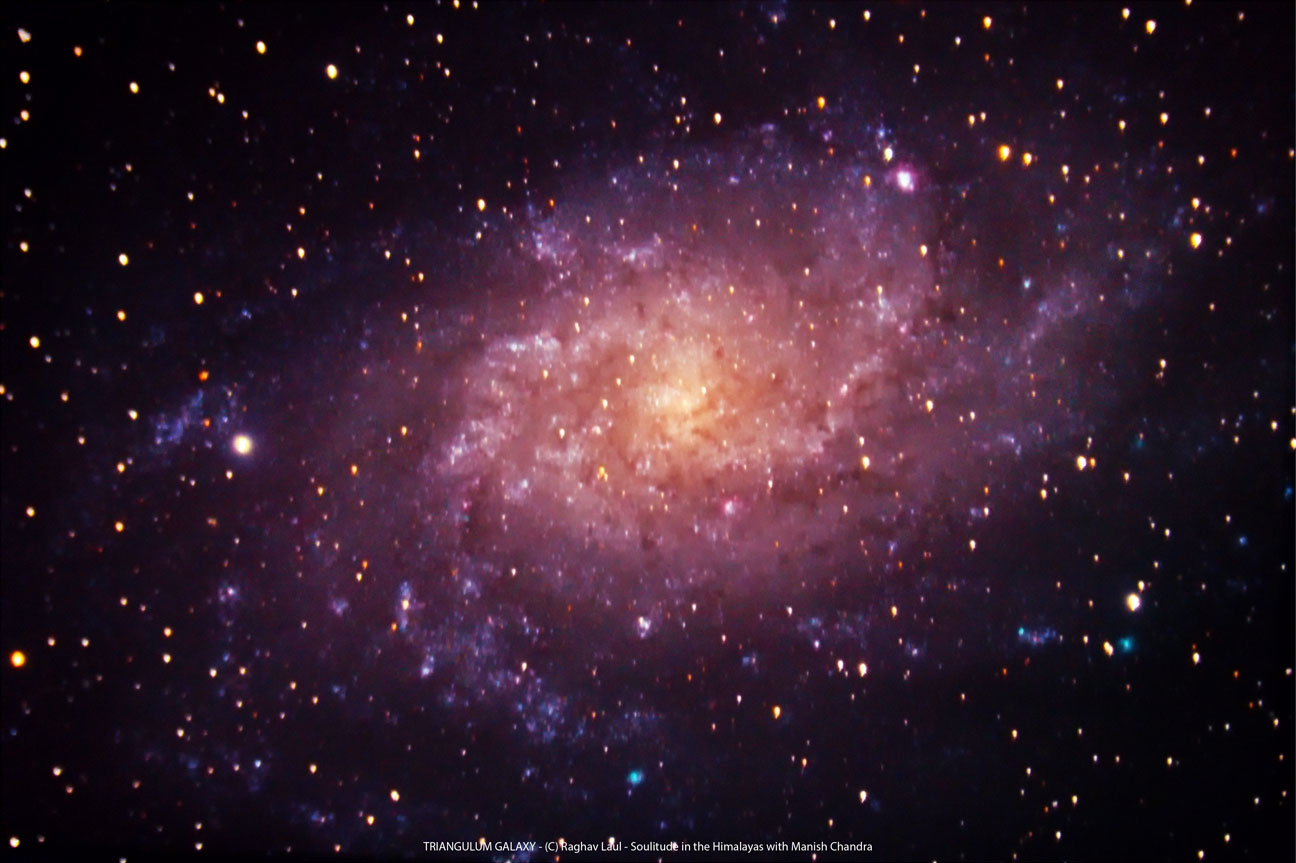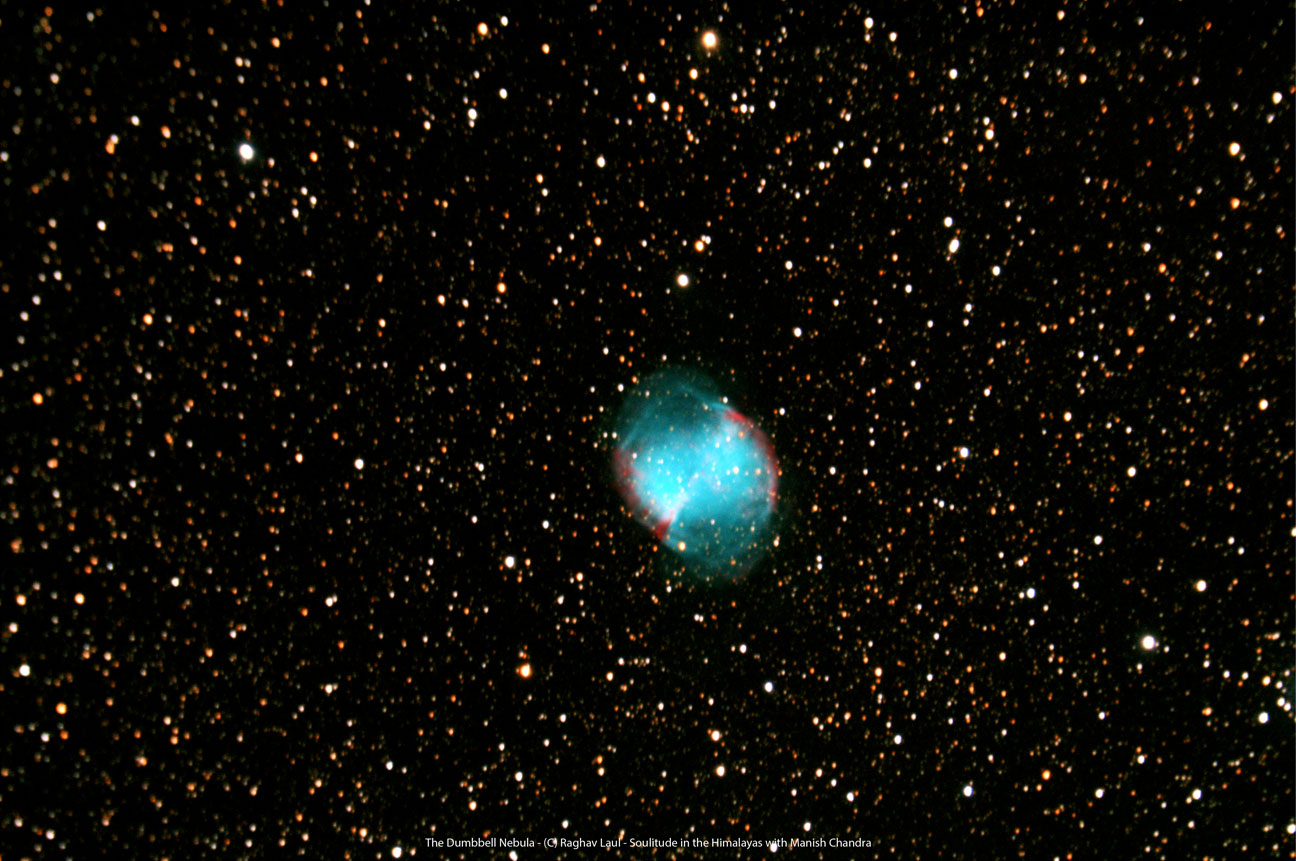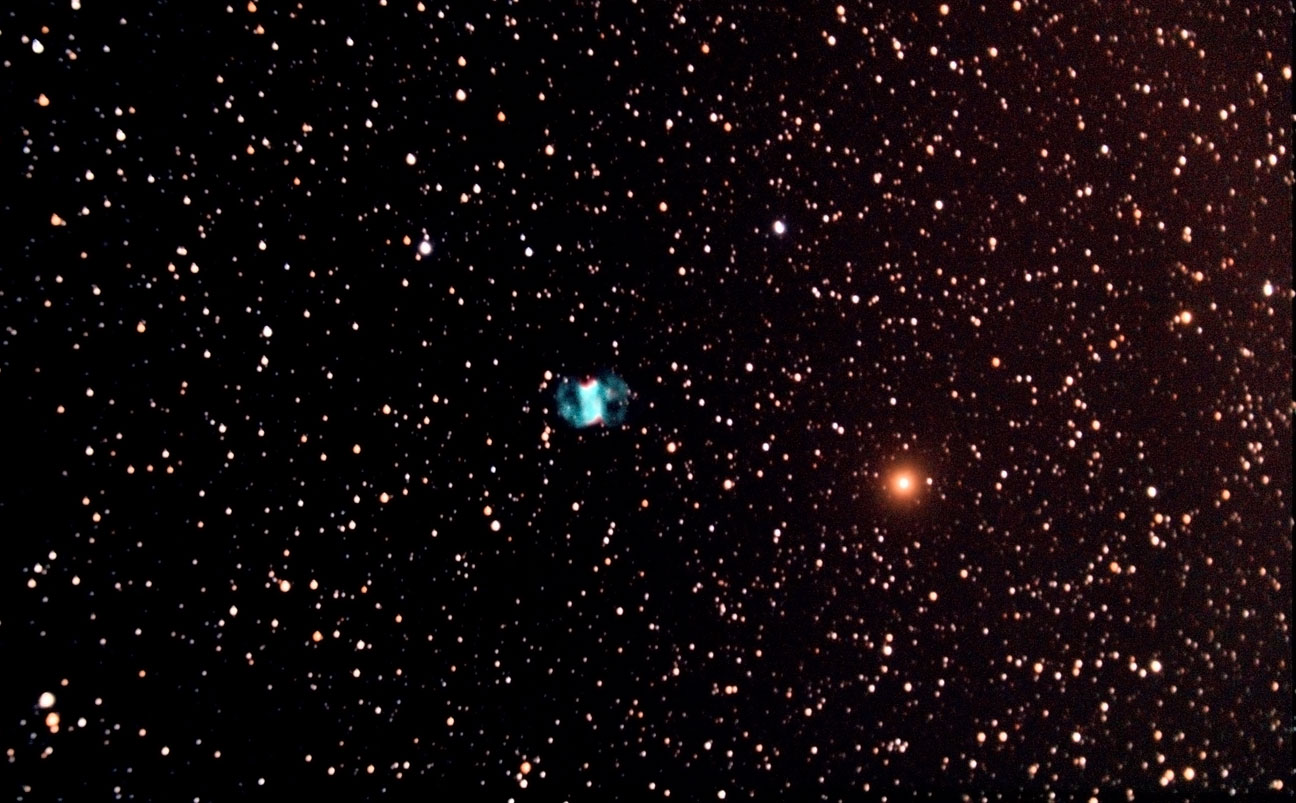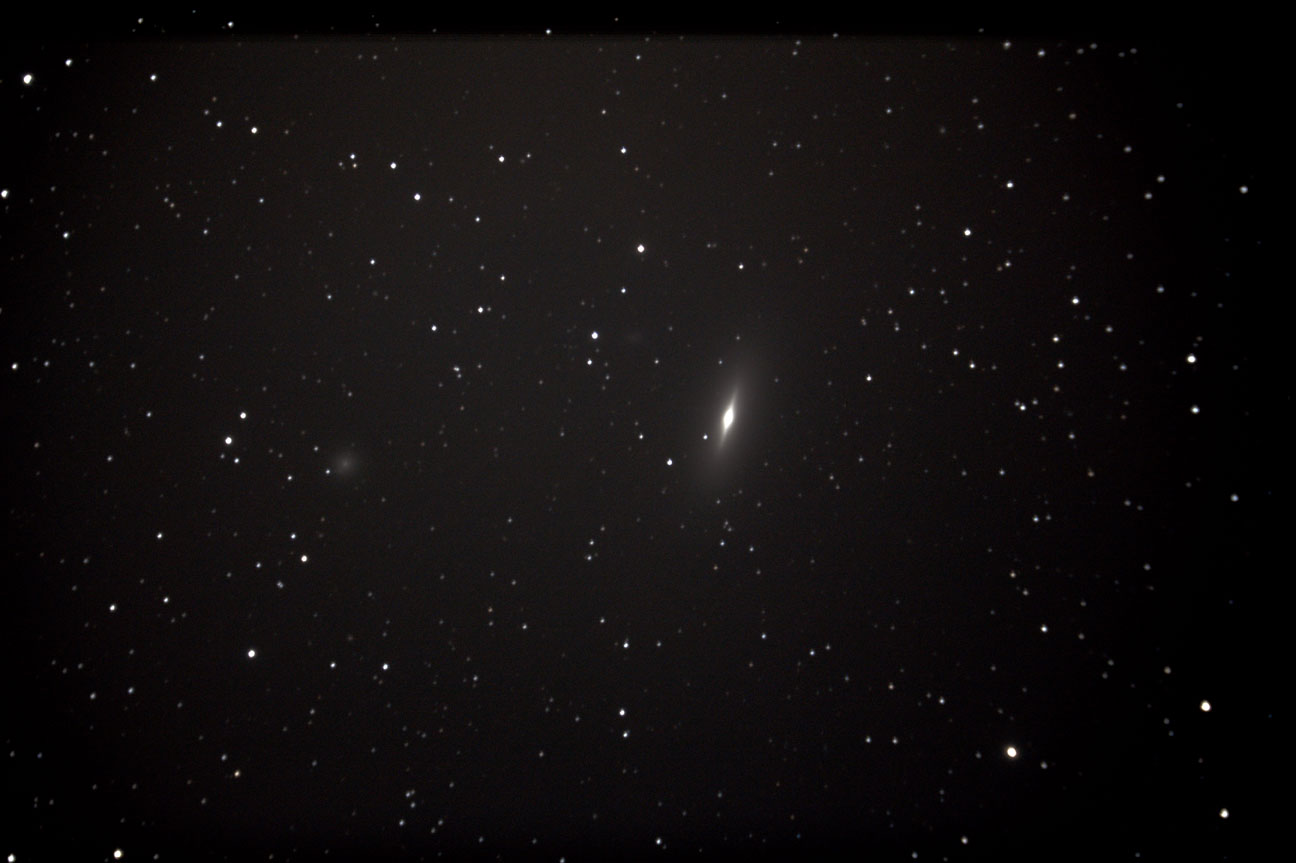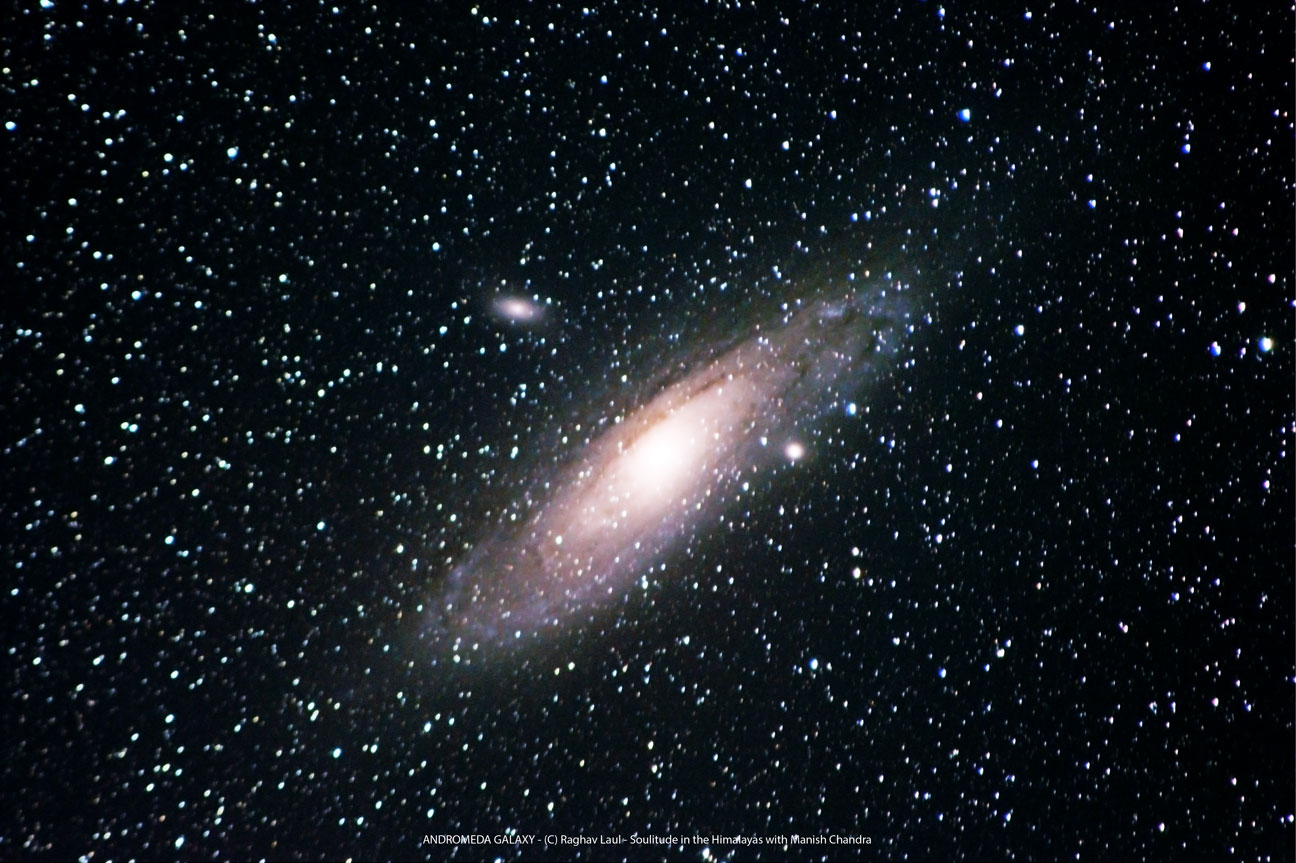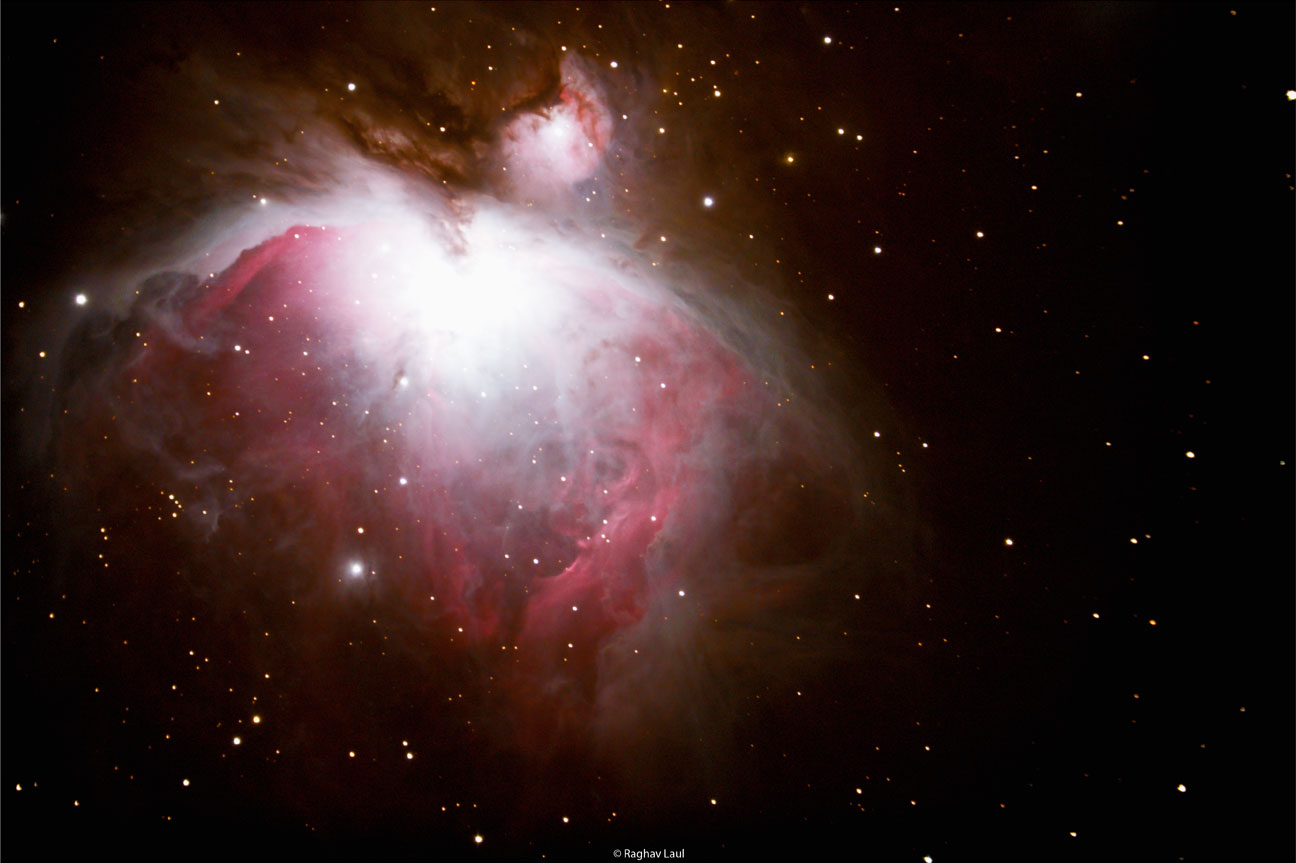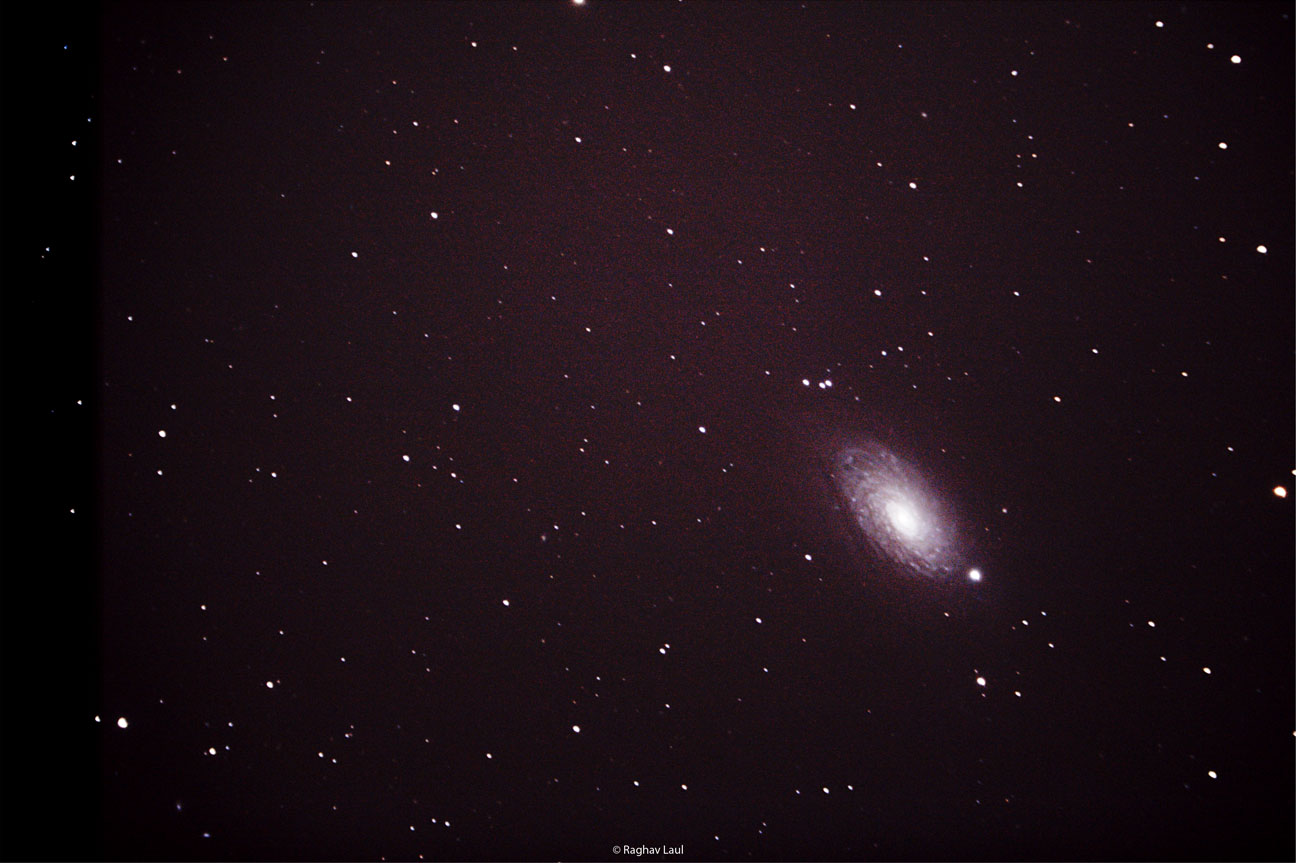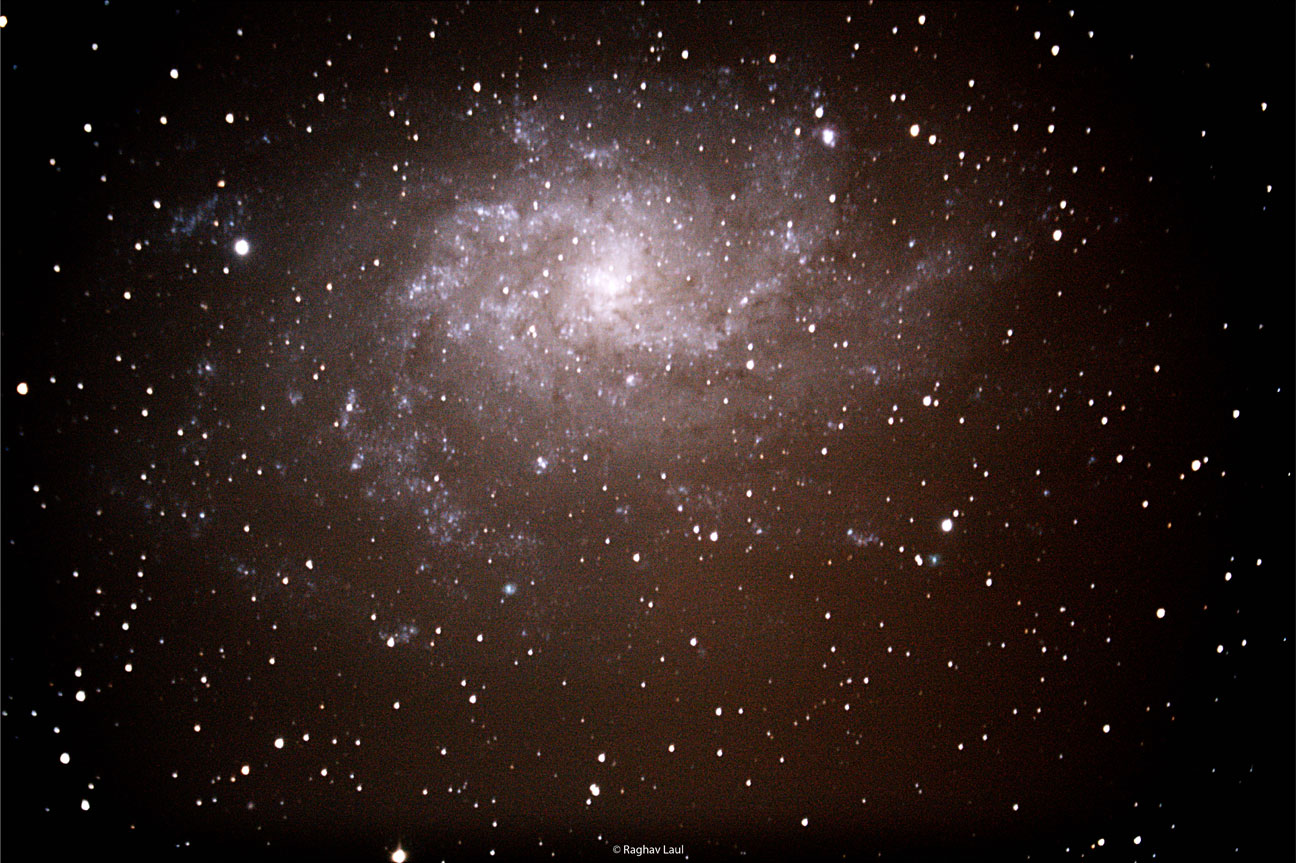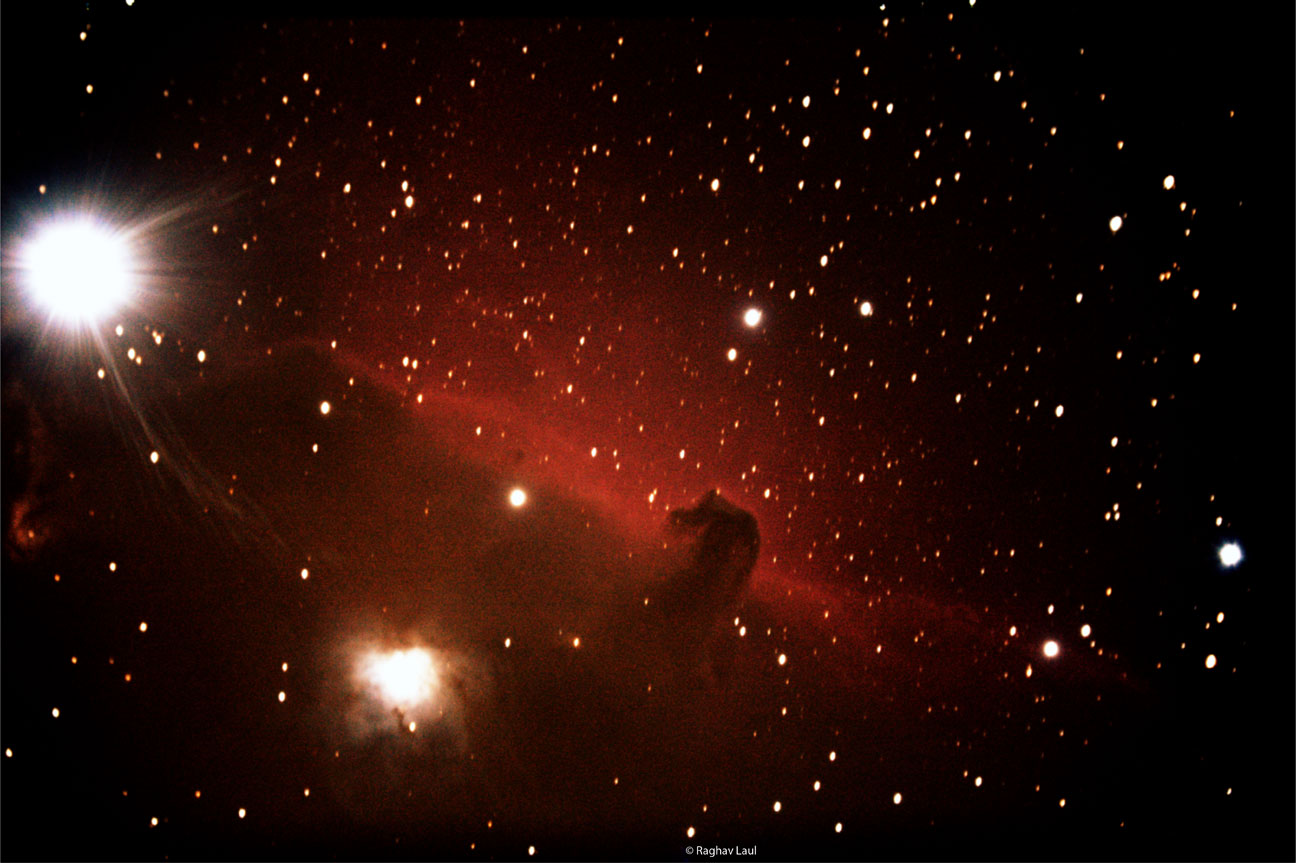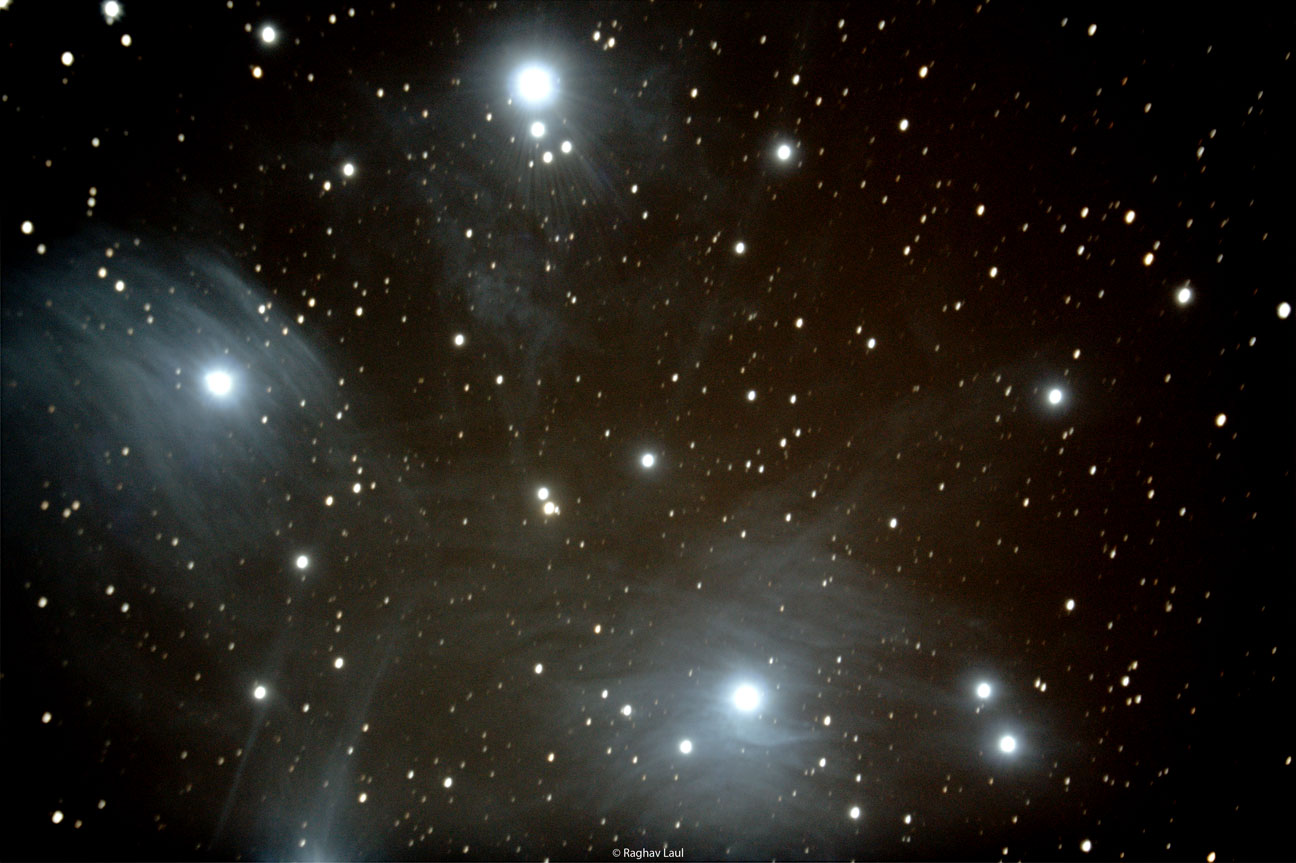Astronomy is one of the oldest sciences. It is the study of celestial objects. Soulitude offers a perfect location for Astronomers to gaze upon the stars, galaxies, planets, moons, asteroids, comets and nebulae. Fulfill your stargazing dreams with unparalleled views of the night sky. Below are some of pictures taken by Raghav Laul at Soulitude in the Himalayas
The Sunflower Galaxy – Messier 63 (also known as M63, NGC 5055, or the Sunflower Galaxy) is a spiral galaxy in the constellation Canes Venatici (at close to distance of 20M Light years) consisting of a central disc surrounded by many short spiral arm segments. M63 is party of the M51 Group, a group of galaxies that also includes M51 (the ‘Whirlpool Galaxy’). M63 is an active galaxy with a LINER nucleus. M63 was dicovered by Pierre MEchain on June 14, 1779. the galaxy was then listed by Charles Messier as object 63 in the Messier Catalogue. In the mid-19th century, Loard Rosse identified spiral structures within the galaxy, making this one of the first galaxies in which such structure was identified. In 1971, a supernova with a magnitude of 11.8 appeared in one of the arms of M63.
IMAGE CREDIT : Raghav Laul
IMAGE TAKEN AT: Soulitude in the Himalayas with Manish Chandra
EQUIPMENT USED: Celestron 9 1/4 inch SGT with EOS 550D via Prime Focus + f/6.3 focal reducer
Triangulum Galaxy is spiral galaxy approximately 3 million light-years(ly) from Earth in the constellation Triangulum. It is catalougues as Messier 33 or NGC 598, and is sometimes informally referred to as the Pinwheel Galaxy, a nickname it shares with Messier 101. The Triangulum Galaxy is the third-largest memeber of the Local Group of galaxies, which includes the Milky Way, the Andromeda Galaxy and about 44 other smaller galaxies. It is one of the most distant permanent objects that can be viewed with the naked eye. The galaxy is the smallest spiral galaxy in the Local Group and it is beleived to be a satellite of the Andromeda Galaxy due to their interactions, velocities and proximity to one another in the night sky.
IMAGE CREDIT : Raghav Laul
IMAGE TAKEN AT: Soulitude in the Himalayas with Manish Chandra
EQUIPMENT USED: Celestron 9 1/4 inch SGT with EOS 550D via Prime Focus + f/6.3 focal reducer
The Dumbbell Nebula (also known as Apple Core Nebula, Messier 27, M27, or NGC 6835) is a planetary nebula in the constellation Vulpecula at a distance of about 1,360 light-years. the object was the first planetary nebula to be discovered; by Charles Messier in 1764. At its brightness of visual magnitude 7.5 and its diameter of about 8 arcminutes, it is easily visible in binoculars, and a popular observing target in amateur telescopes. the Dumbbell Nebula appears to be shaped like an prolate spheroid and is viewed from our perspective along the plane of its equator. In 1992, Moreno-Corral et al. computed that its rate of expansion in the plane of the sky was no more than 2.3″ per century. From this, an upper limit to the age of 14,600 yr may be dtermined. The central star, a white dwarf, is estimated to have a radius which is 0.055+0.02 R which gives it a size larger than any other known white dwarf.
IMAGE CREDIT : Raghav Laul
IMAGE TAKEN AT: Soulitude in the Himalayas with Manish Chandra
EQUIPMENT USED: Celestron 9 1/4 inch SGT with EOS 550D via Prime Focus + f/6.3 focal reducer
Little Dumbbell Nebula – A Bit of Weightlifting – Presenting the Little Dumbbell Nebula. Approx 2500 light years away and a smaller sibling to the Dumbbell Nebula, which, hopefully, I shall also get soon! The structure is now classed as a bipolar planetary nebula. It was originally thought to consist of two separate emission nebulae and was thus given two catalog numbers in the NGC 650 and 651. Some consider this object to be one of the faintest and hardest to see objects in Messier’s list.
IMAGE CREDIT : Raghav Laul
IMAGE TAKEN AT: Soulitude in the Himalayas with Manish Chandra
Spindle Galaxy – NGC 5866 (also called the Spindle Galaxy or Messier 102) is a relatively bright lenticular or spiral galaxy in the constellation Draco. NGC 5866 was probably discovered by Pierre Méchain or Charles Messier in 1781, and independently found by William Herschel in 1788. One of the most outstanding features of NGC 5866 is the extended dust disk, which is seen almost exactly edge-on. This dust disk is highly unusual for a lenticular galaxy. The dust in most lenticular galaxies is generally found only near the nucleus and generally follows the light profile of the galaxies’ bulges. This dust disk may contain a ring-like structure, although the shape of this structure is difficult to determine given the edge-on orientation of the galaxy. It is also possible that the galaxy is a spiral galaxy that was misclassified as a lenticular galaxy because of its edge-on orientation, in which case the dust disk would not be too unusual.
IMAGE CREDIT : Raghav Laul
IMAGE TAKEN AT: Soulitude in the Himalayas with Manish Chandra
The Andromeda Galaxy – The Andromeda Galaxy, also known as Messier 31, M31, or NGC 224, is a special galaxy approximately 780 kiloparsecs (2.5 million light-years) from Earth. It is the nearest majo galaxy to the Milky Way and was often referred to as the Great Andromeda Nebula in older texts. It received its name from the area of the sky in which it appears, the constellation of Andromeda, which was named after the mythological princess Andromeda. Andromeda is approximately 220,000 light years across, and it is the largest galaxy of the Local Group, which also contains the Milky Way, the Triangulum Galaxy, and other smaller galaxies. Despite earlier findings that suggested that the Milky Way contains more dark matter and could be the largest in the grouping, the 2006 observations by the Spitzer Space Telescope revealed that Andromeda contains one trillion stars: at least twice the number of stars in the Milky Way. Which is estimated to be 200-400 billion. The mass of the Andromeda Galaxy is estimated to be 1.501012 solar masses, while the Milky Way is estimated to be 8.501011 solar masses. The Milky way and Andromeda galaxies are expected to collide in the 4.5 billion years, eventually merging to form a giant elliptical galaxy or perhaps a large disc galaxy. The apparent magnitude of the Andromeda Galaxy, at 3.4, is among the brightest of the Messier objects, making it visiible to the naked eye on moonless nights, even when viewed from areas with moderate light pollution.
IMAGE CREDIT : Raghav Laul
IMAGE TAKEN AT: Soulitude in the Himalayas with Manish Chandra
EQUIPMENT USED: Celestron Advanced VX mount with EOS 550D 7-300mm.
The ORION Nebula – The Orion Nebula (also known as Messier 42, M42, or NGC 1976) is diffuse nebula situated south of Orion’s Belt in the constellation of Orion. It is one of the brightest nebulae, and is visible to the naked eye in the night sky. M42 is located at the a distance of 1,344 + 20 light years and is the closest region of massive star formation to Earth.
IMAGE CREDIT : Raghav Laul
IMAGE TAKEN AT: Soulitude in the Himalayas with Manish Chandra
EQUIPMENT USED: Celestron 9 1/4 inch SGT with EOS 550D via Prime Focus + f/6.3 focal reducer
Messier 63 (also known as M63, NGC S055, or the Sunflower Galaxy) is a spiral galaxy in the constellation Canes Venatici consisiting of a central disc surronunded by many short spiral arm segments. M63 is part of the M51 Group, a group of galaxies that also includes M51 (the ‘Whirlpool Galaxy’). M63 is an active galaxy with LINER nucleus. M63 was discovered by Pierre Mechain on June 14, 1779. The Galaxy was then listed by Charles Messier as object 63 in the Messier Catalouge.
In the mid 19th century, Lord Rosse identified spiral structures within the galaxy, making this one of the first galaxies in which such structure was identified. In 1971, a supernova with magnitude of 11.8 appeared in one of the arms of M63.
IMAGE CREDIT : Raghav Laul
IMAGE TAKEN AT: Soulitude in the Himalayas with Manish Chandra
EQUIPMENT USED: Celestron 9 1/4 inch SGT with EOS 550D via Prime Focus + f/6.3 focal reducer
The Pinwheel Galaxy (also known as Messier 101, M101 or NGC 5457) is a face-on spiral galaxy distanced 21 million light years (six megaparsecs) away in the constellation Ursa Major, first discoverd by Pierre Mechain on March 27, 1781, and communicated to Charls Messier who verified its position for inclusion in the Messier Catalogue as one of its final entries. On February 28, 2006, NASA and the ESA released a very detailed image of the Pinwheel Galaxy, which was the largest and most detailed image of a galaxy by Hubble Space Telescope at the time. The image was composed from 51 individual exposures, plus some extra ground-based photos. On August 24, 2011, a Type la supernova, SN 2011fe, was discovered in M101. M101 is a large glalaxy comparable in size to the Milky Way. With a diameter of 170,000 light years it is roughly equal the size of Milky Way. It has a disk mass on the order of 100 billion solar masses, along with a small central bulge of about 3 billion solar masses
IMAGE CREDIT : Raghav Laul
IMAGE TAKEN AT: Soulitude in the Himalayas with Manish Chandra
EQUIPMENT USED: Celestron 9 1/4 inch SGT with EOS 550D via Prime Focus + f/6.3 focal reducer
The Horsehead Nebula (also known as Barnard 33) is a dark nebula in the constellation Orion. The Horsehead Nebula is approximately 1500 light years from earth. It is one of the most identifiable nebulae because of the shape of its swirling cloud of dark dust and gases, which bears some resemblance to a horse’s head when viewed from Earth. The dark cloud of dust and gas is a region in the Orion Molecular Cloud Complex where star formation is taking place. This stellar nursery, as it is know, can contain over 100 known organic and inorganic gases as well as dust consisting of large and complex organic molecules. The red or pinkish glow originates from hydrogen gas predominantly behind the nebula, ionized by the nearby bright star Sigma Orionis. Magnetic fields channel the gases leaving the nebula into streams, shown as streaks in the background glow.
IMAGE CREDIT : Raghav Laul
IMAGE TAKEN AT: Soulitude in the Himalayas with Manish Chandra
EQUIPMENT USED: Celestron 9 1/4 inch SGT with EOS 550D via Prime Focus + f/6.3 focal reducer
In astronomy, the Pleiades, or Seven Sisters (Messier 45 or M45) is an open star cluster containing middle-aged hot B-type stars located in the constellation of Taurus. It is among the nearest star clusters to Earth and is the cluster most obvious to the naked eye in the night sky. The celestial entity has several meanings in different cultures and traditions. The cluster is dominated by hot blue and extremely luminous stars that have formed within the lst 100 million years. Dust that forms a faint reflection nebulosity around the brightest stars was thought at first to be left over from the formation of the cluster (hence the alternative name Maia Nebula after the star Maia), but is now known to be an unrelated dust cloud in the interstellar medium, through which the stars are currently passing. Computer simulations have shown that the Pleiades was probably formed from the compact configuration that resembled the Orion Nebula. Astronomers estimate that the cluster will survive for about another 250 million years, after which it will disperse due to gravitational interactions with its galactic neighborhood.
IMAGE CREDIT : Raghav Laul
IMAGE TAKEN AT: Soulitude in the Himalayas with Manish Chandra
EQUIPMENT USED: Celestron 9 1/4 inch SGT with EOS 550D via Prime Focus + f/6.3 focal reducer
Raghav Laul’s tryst with the deep skies began when his parents bought him a Sharp Vision Telescope from the India Hobby Centre for his 12th birthday. One look through the lens, and he was hooked, for life. Over the last decade he has painstakingly collected software and equipment (he chose to buy a Celestron telescope with his first years salary when all his colleagues were buying cars) teaching himself by trial and error, and travelling far and wide in search of clear skies. By day, he works for an MNC in Delhi, where he lives with his wife and new born son.


